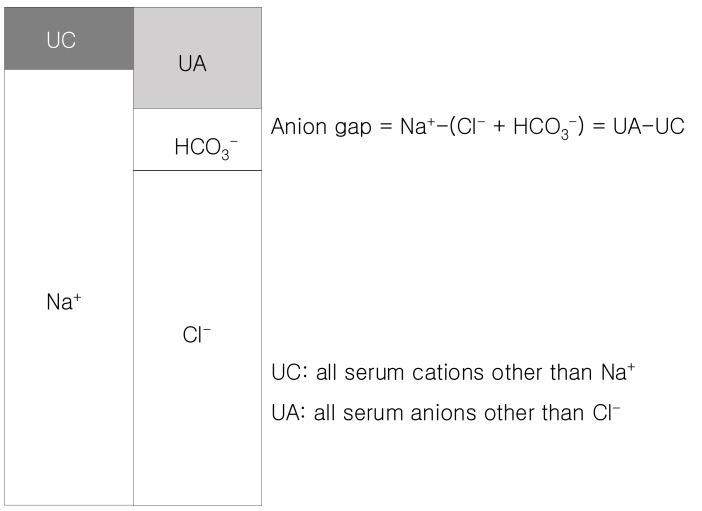Electrolyte Blood Press.
2006 Mar;4(1):44-46. 10.5049/EBP.2006.4.1.44.
Clinical Usefulness of the Serum Anion Gap
- Affiliations
-
- 1Division of Nephrology, Department of Internal Medicine, Chonbuk National University Medical School, Chonbuk, Korea. hope@chonbuk.ac.kr
- KMID: 2052268
- DOI: http://doi.org/10.5049/EBP.2006.4.1.44
Abstract
- The anion gap in the serum is useful in the interpretation of acid-base disorders and in the diagnosis of other conditions. In the early 1980s, ion-selective electrodes for specific ionic species were introduced for the measurement of serum electrolytes. This new method has caused a shift of the anion gap from 12+/-4 mEq/L down 6+/-3 mEq/L. It is worthy for clinicians to understand the range of normal anion gap and the measuring methods for serum sodium and chloride in the laboratories that support their practice. While an increase in the anion gap is almost always caused by retained unmeasured anions, a decrease in the anion gap can be generated by multiple mechanisms.
MeSH Terms
Figure
Reference
-
1. Oh MS, Carroll HJ. Current concepts : the anion gap. N Engl J Med. 1977; 297:814–817. PMID: 895822.2. Winter SD, Pearson J, Gabow PA. The fall of the serum anion gap in the diagnosis of acid base disorders. Arch Intern Med. 1990; 150:311–313. PMID: 2302006.3. Adrogue HJ, Madias NE. Management of life-threatening acid-base disorders : First of two parts. N Engl J Med. 1998; 338:26–34. PMID: 9414329.4. Oster JR, Perez GO, Materson BJ. Use of the anion gap in clinical medicine. South Med J. 1988; 81:229–237. PMID: 3277288.
Article5. Hertford JA, McKenna JP, Chamovitz BN. Metabolic acidosis with an elevated anion gap. Am Fam Physician. 1989; 39:159–168. PMID: 2650500.6. Ishihara K, Szerlip HM. Anion gap acidosis. Semin Nephrol. 1998; 18:83–97. PMID: 9459291.7. Keshgegian AA. Anion gap and immunoglobulin concentration. Am J Clin Pathol. 1980; 74:282–284. PMID: 7416079.
Article8. De Troyer A, Stolarczyk A, De Beyl DZ, Stryckmans P. Value of anion-gap determination in multiple myeloma. N Engl J Med. 1977; 296:858–860. PMID: 846496.
Article9. Murray T, Long W, Narins RG. Multiple myeloma and the anion gap. N Engl J Med. 1975; 292:574–575. PMID: 234173.
Article10. Figge J, Jabor A, Kazda A, Fencl V. Anion gap in hypoalbuminemia. Crit Care Med. 1998; 26:1807–1810. PMID: 9824071.11. Durward A, Mayer A, Skellet S, Taylor D, Hanna S, Tibby SM, Murdoch IA. Hypoalbuminemia in critically ill children : incidence, prognosis, and influence on the anion gap. Arch Dis Child. 2003; 88:419–422. PMID: 12716714.
- Full Text Links
- Actions
-
Cited
- CITED
-
- Close
- Share
- Similar articles
-
- The Metabolic Acidosis and Clinical Outcome in Acute Infantile Diarrhea
- Significance of an Anion Gap and an Osmol Gap in Poisoning
- Diagnosing metabolic acidosis in chronic kidney disease: importance of blood pH and serum anion gap
- Correlation of Urine Ammonium with Urine Osmolal Gap in High Anion Gap Matabolic Acidosis: Comparison to Urine Anion Gap
- Serum Electrolyte and Acid Base Composition in Patients with Graded Degrees of Chronic Renal Failure


